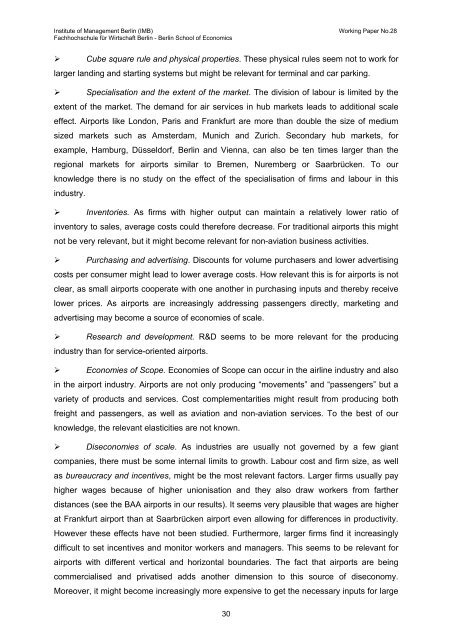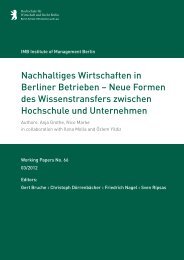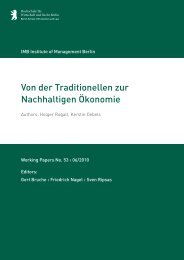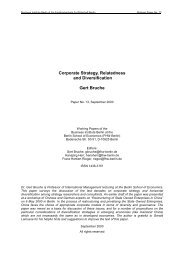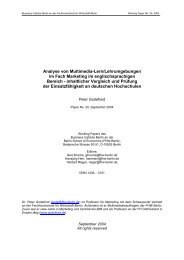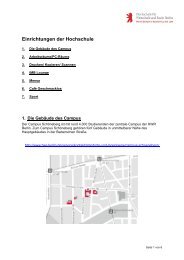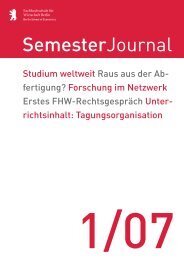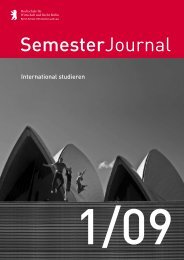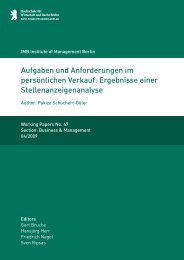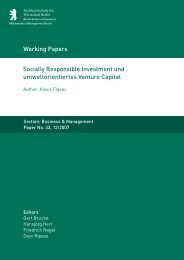Working paper template - MBA Programme der HWR Berlin
Working paper template - MBA Programme der HWR Berlin
Working paper template - MBA Programme der HWR Berlin
Create successful ePaper yourself
Turn your PDF publications into a flip-book with our unique Google optimized e-Paper software.
Institute of Management <strong>Berlin</strong> (IMB) <strong>Working</strong> Paper No.28<br />
Fachhochschule für Wirtschaft <strong>Berlin</strong> - <strong>Berlin</strong> School of Economics<br />
� Cube square rule and physical properties. These physical rules seem not to work for<br />
larger landing and starting systems but might be relevant for terminal and car parking.<br />
� Specialisation and the extent of the market. The division of labour is limited by the<br />
extent of the market. The demand for air services in hub markets leads to additional scale<br />
effect. Airports like London, Paris and Frankfurt are more than double the size of medium<br />
sized markets such as Amsterdam, Munich and Zurich. Secondary hub markets, for<br />
example, Hamburg, Düsseldorf, <strong>Berlin</strong> and Vienna, can also be ten times larger than the<br />
regional markets for airports similar to Bremen, Nuremberg or Saarbrücken. To our<br />
knowledge there is no study on the effect of the specialisation of firms and labour in this<br />
industry.<br />
� Inventories. As firms with higher output can maintain a relatively lower ratio of<br />
inventory to sales, average costs could therefore decrease. For traditional airports this might<br />
not be very relevant, but it might become relevant for non-aviation business activities.<br />
� Purchasing and advertising. Discounts for volume purchasers and lower advertising<br />
costs per consumer might lead to lower average costs. How relevant this is for airports is not<br />
clear, as small airports cooperate with one another in purchasing inputs and thereby receive<br />
lower prices. As airports are increasingly addressing passengers directly, marketing and<br />
advertising may become a source of economies of scale.<br />
� Research and development. R&D seems to be more relevant for the producing<br />
industry than for service-oriented airports.<br />
� Economies of Scope. Economies of Scope can occur in the airline industry and also<br />
in the airport industry. Airports are not only producing “movements” and “passengers” but a<br />
variety of products and services. Cost complementarities might result from producing both<br />
freight and passengers, as well as aviation and non-aviation services. To the best of our<br />
knowledge, the relevant elasticities are not known.<br />
� Diseconomies of scale. As industries are usually not governed by a few giant<br />
companies, there must be some internal limits to growth. Labour cost and firm size, as well<br />
as bureaucracy and incentives, might be the most relevant factors. Larger firms usually pay<br />
higher wages because of higher unionisation and they also draw workers from farther<br />
distances (see the BAA airports in our results). It seems very plausible that wages are higher<br />
at Frankfurt airport than at Saarbrücken airport even allowing for differences in productivity.<br />
However these effects have not been studied. Furthermore, larger firms find it increasingly<br />
difficult to set incentives and monitor workers and managers. This seems to be relevant for<br />
airports with different vertical and horizontal boundaries. The fact that airports are being<br />
commercialised and privatised adds another dimension to this source of diseconomy.<br />
Moreover, it might become increasingly more expensive to get the necessary inputs for large<br />
30


